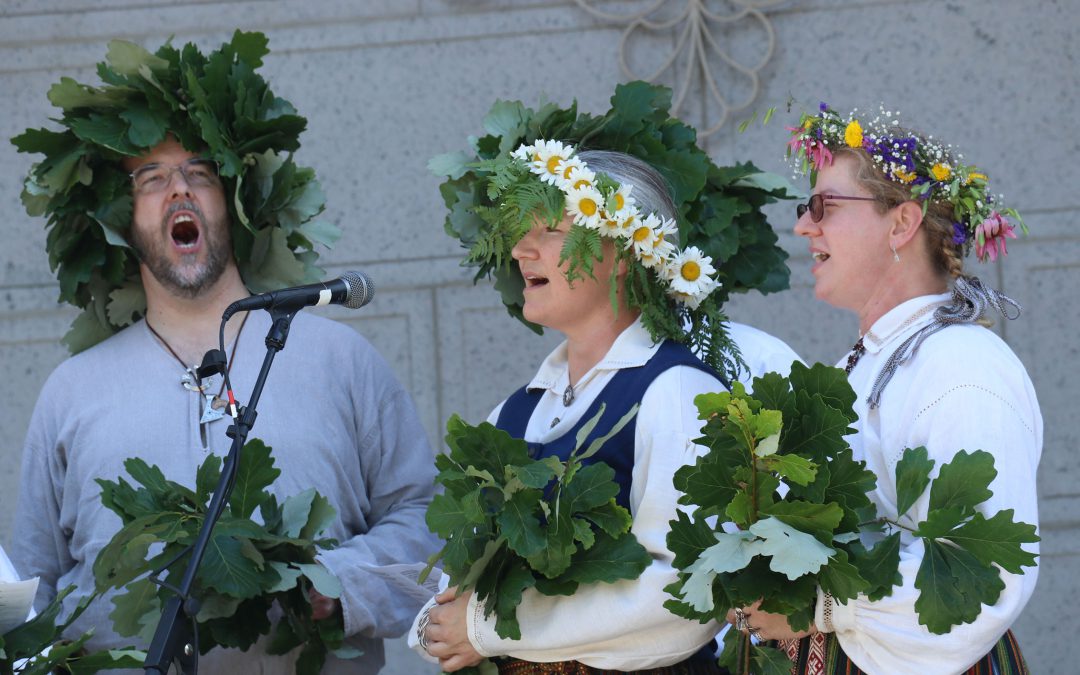WASHINGTON — Every year the National Mall in Washington, D.C. comes alive during the summer for the Smithsonian Folklife Festival, touted as an ‘international exposition of living cultural heritage’ organized by the Smithsonian Institution’s Center for Folklife and Cultural Heritage. This year’s edition was held June 29 and 30, near the Freer-Sackler Galleries of Art on the National Mall. The theme this year was “The Social Power of Music” and programs wove together lyricism and political activism in a celebration of the many aspects of American cultural life during a politically charged time. Musical workshops, music history stalls and cider also formed part of the musical weekend.
A couple checks out music posters on a pillar at the Smithsonian Folklife Festival. These posters included both contemporary ones and copies from archival material– such as the one announcing a performance by Chuck Brown and the Soul Searchers at Waterside Mall, and a Martin Luther King Jr. Concert for Justice held at the Sylvan Theater. (Sruthi Darbhamulla/Medill News Service)
The stage is set for the Royal Pocket Tour, a collection of noted Go-go players, such as lyricist and rapper Stinky Dink, performing on assorted percussion instruments on the first day of the Smithsonian Folklife Festival. The group was brought together by DC activist Ron Moten to showcase the rich tradition of Go-go music in Washington DC. It was so named for a long rhythmic break in Go-go music known as a pocket. (Sruthi Darbhamulla/Medill News Service)
Filipino-American singer Ruby Ibarra takes to the main stage on Day 1 of the festival. Ibarra, who is from California, raps about the Filipino immigrant experience and about the peculiar challenges faced by brown people in America. (Sruthi Darbhamulla/Medill News Service)
Folklife festival attendee Arzanah Opon wears a shirt with lyrics from a Ruby Ibarra song. She discovered Ibarra’s music this February. “I saw no representation of Filipina Americans, till I heard her music…. She has an almost similar story to mine,” Opon, a second-generation Filipino immigrant, said. She was attending the concert with her boyfriend Elliott Kittel, whose mother was a first-generation immigrant, and they said they bonded over Ibarra’s music. (Sruthi Darbhamulla/Medill News Service)
The crowd hangs around the main stage right before a performance during the “Fierce Urgency of Now: Modern Troubadours, Poets and Wordsmiths” session on the evening of June 29. (Sruthi Darbhamulla/Medill News Service)
Martha Gonzalez of the Chicano rock band Quetzal performs during the “Fierce Urgency of Now: Modern Troubadours, Poets and Wordsmiths” on the evening of June 29. (Sruthi Darbhamulla/Medill News Service)
A little girl plays in a drum circle led by Sue Pahl and Jonathan Murray on the second day of the Smithsonian Folklife Festival. Festival attendees could join a fresh drum circle every half hour from 11 am to 3 pm on June 30. (Sruthi Darbhamulla/Medill News Service)
A Latvian choir performs traditional summer songs on the steps of an art gallery on the second day of the festival. The performance was part of a showcase of Baltic heritage, which also included Lithuanian folk dances and an Estonian potato sack race. (Sruthi Darbhamulla/Medill News Service)
Performers and audience members share an informal stage as a Latvian choir performs traditional summer songs on the steps of an art gallery on the second day of the festival. (Sruthi Darbhamulla/Medill News Service)
Rytis Grybauskas of the Lithuania dance group Malunas (which means ‘windmill’ in Lithuanian) leads the crowd in a dance at the festival. (Sruthi Darbhamulla/Medill News Service)
Lithuanian folk-dance group Malunas performs on Day 2 of the festival. The group generally performs with 16 dancers. (Sruthi Darbhamulla/Medill News Service)
The crowd is on its feet for a performance by Grandmaster Flash in what was the final program for the Smithsonian Folklife Festival. Titled “Hip-hop: People, Places and Things- A Video Experience for families,” the performance traced the journey of hip-hop in a lyrical video presentation interlaced with thumping musical beats. (Sruthi Darbhamulla/Medill News Service)

